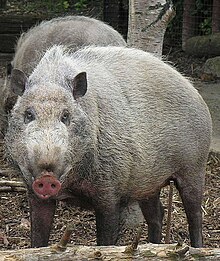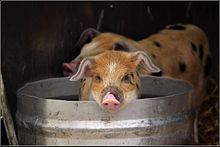| Pig Temporal range: Early Pleistocene to recent | |
|---|---|
 | |
| Bornean bearded pig at the London Zoo. |
A pig is any of the animals in the genus Sus, within the even-toed ungulate familySuidae. Pigs include the domestic pig and its ancestor, the common Eurasian wild boar(Sus scrofa), along with other species. Related creatures outside the genus include the peccary, the babirusa, and the warthog. Pigs, like all suids, are native to the Eurasian and African continents. Juvenile pigs are known as piglets.[1] Pigs are highly social and intelligent animals.[2]
With around 1 billion individuals alive at any time, the domestic pig is among the most populous large mammals in the world.[3][4] Pigs are omnivores and can consume a wide range of food.[5] Biologically, pigs are very similar to humans, thus are frequently used for human medical research.[6]
...
Description and behaviour
A typical pig has a large head with a long snout that is strengthened by a special prenasal bone and by a disk of cartilage at the tip.[8] The snout is used to dig into the soil to find food and is a very acute sense organ. There are four hoofed toes on each foot, with the two larger central toes bearing most of the weight, but the outer two also being used in soft ground.[9]
The dental formula of adult pigs is 3.1.4.33.1.4.3, giving a total of 44 teeth. The rear teeth are adapted for crushing. In the male, the canine teeth form tusks, which grow continuously and are sharpened by constantly being ground against each other.[8]
Occasionally, captive mother pigs may savage their own piglets, often if they become severely stressed.[10] Some attacks on newborn piglets are non-fatal. Others may cause the death of the piglets and sometimes, the mother may eat the piglets. It is estimated that 50% of piglet fatalities are due to the mother attacking, or unintentionally crushing, the newborn pre-weaned animals.[11]
Distribution and evolution
With around 1 billion individuals alive at any time, the domestic pig is one of the most numerous large mammals on the planet.[3][4]
The ancestor of the domestic pig is the wild boar, which is one of the most numerous and widespread large mammals. Its many subspecies are native to all but the harshest climates of continental Eurasia and its islands and Africa as well, from Ireland and India to Japan and north to Siberia.
Long isolated from other pigs on the many islands of Indonesia, Malaysia, and the Philippines, pigs have evolved into many different species, including wild boar, bearded pigs, and warty pigs. Humans have introduced pigs into Australia, North and South America, and numerous islands, either accidentally as escaped domestic pigs which have gone feral, or as wild boar.
Habitat and reproduction
The wild pig (Sus scrofa) can take advantage of any forage resources. Therefore, it can live in virtually any productive habitat that can provide enough water to sustain large mammals such as pigs. If there is increased foraging of wild pigs in certain areas, it can cause a nutritional shortage which can cause the pig population to decrease. If the nutritional state returns to normal, the pig population will most likely rise due to the pigs' naturally increased reproduction rate.[12]
Diet and foraging
Pigs are omnivores, which means that they consume both plants and animals. In the wild, they are foraging animals, primarily eating leaves, roots, fruits, and flowers, in addition to some insects and fish. As livestock, pigs are fed mostly corn and soybean meal[13] with a mixture of vitamins and minerals added to the diet. Traditionally, they were raised on dairy farms and called "mortgage lifters", due to their ability to use the excess milk as well as whey from cheese and butter making combined with pasture.[14] Older pigs will consume three to five gallons of water per day.[15] When kept as pets, the optimal healthy diet consists mainly of a balanced diet of raw vegetables, although some may give their pigs conventional mini pig pellet feed.[16]
Relationship with humans
Domesticated pigs, especially miniature breeds, are commonly kept as pets.[17] Domestic pigs are raised commercially as livestock; materials that are garnered include their meat (known as pork), leather, and their bristly hairs which are used to make brushes. Because of their foraging abilities and excellent sense of smell, they are used to find truffles in many European countries. Both wild and feral pigs are commonly hunted.
The relatively short, stiff, coarse hairs of the pig are called bristles, and were once so commonly used in paintbrushes that in 1946 the Australian Government launched Operation Pig Bristle. In May 1946, in response to a shortage of pig bristles for paintbrushes to paint houses in the post-World War II construction boom, the Royal Australian Air Force (RAAF) flew in 28 short tons of pig bristles from China, their only commercially available source at the time.[18]
Use in human healthcare
Human skin is very similar to pig skin, therefore pig skin has been used in many preclinical studies.[19][20] In addition to providing use in biomedical research[21][19][20] and for drug testing,[22] genetic advances in human healthcare have provided a pathway for domestic pigs to become xenotransplantation candidates for humans.[23]
...
In religion
- In ancient Egypt, pigs were associated with Set, the rival to the sun god Horus. When Set fell into disfavor with the Egyptians, swineherds were forbidden to enter temples. According to Herodotus, swineherds were a kind of separate sect or caste, which only married among themselves. Egyptians regarded pigs as unworthy sacrifices to their gods other than the Moon and Dionysus, to whom pigs were offered on the day of the full Moon. Herodotus states that, though he knew the reason why Egyptians abominated swine at their other feasts but they sacrificed them at this one; however, it was to him "not a seemly one for me to tell".[34]
- In ancient Greece, a sow was an appropriate sacrifice to Demeter and had been her favorite animal since archaic times. Initiates at the Eleusinian Mysteries began by sacrificing a pig. Pig were also sacrificed to Aphrodite.
- The ancient Romans practiced a sacrifice called the suovetaurilia, in which a pig, a ram, and a bull were sacrificed, as one of the most solemn acts of the Roman religion.
- In Buddhism the deity Marici is often depicted riding in a carriage hauled by several pigs.
- The Celts had a god of swine called Moccus, who under Roman occupation was identified with Mercury. In Celtic mythology, a cauldron overflowing with cooked pork was one of the attributes of The Dagda.
- In the Chinese zodiac, the Pig is one of the 12-year cycle of animals. Believers in Chinese astrology associate each animal with certain personality traits (see: Pig (zodiac)).
- In Christianity the book of Mark, in an event referred to as the exorcism of the Gerasene demoniac Jesus casts the demons Legion (demon) possessing a swine herder from Gerasene; into 2000 of the swine herders pigs.[35]
- In Haitian Vodou, Ezili Dantor, the lwa of motherhood, is associated with the black Creole Pig of Haiti, her favorite animal sacrifice.
- In Hinduism the god Vishnu took the form of a four-armed humanoid with the head of a boar named Varaha in order to save the Earth from a demon who had dragged it to the bottom of the sea.
- In Islam the eating of pork is also sinful (see Haraam). The Qur'an prohibits the consumption of pork in no less than 4 different places. It is prohibited in 2:173, 5:3, 6:145 and 16:115. "Forbidden to you (for food) are: dead meat, blood, the flesh of swine, and that on which hath been invoked the name of other than Allah." [Al-Qur'an 5:3] Islam treats pigs as inedible animals par excellence, the animal that is central to the concepts of haram.
- The dietary laws of Judaism (Kashrut) forbid, among other kinds of meat, the eating of pork in any form, considering the pig to be an unclean animal as food (see taboo food and drink). Pork is as forbidden as the meat of any other unclean animal, but probably due to extensive use of pork in modern days, abhorrence of pork is far stronger and emotional in traditional Jewish culture than that of other forbidden foods. Many Ancient Jews also held the prohibition on pigs above other taboos. In De Specialibus Legibus, Philo of Alexandria, a first-century Jewish writer, relates that pigs were lazy scavengers, the embodiment of vice. Philo also argued that since pigs will eat the flesh of human corpses, that men should abstain from eating them so as not to be contaminated.[36]
- In Nordic Mythology, "Gold-Bristle" or "Gold-Mane" was Freyr's golden boar, created by the dwarves Brokk and Sindri as part of a challenge. His shining fur is said to fill the sky, trees, and sea with light.
- Among Seventh-day Adventists and some other denominations[who?], the eating of pork is prohibited. Most Christians believe that the eating of pork is not prohibited, according to the teachings of the New Testament. In Catholicism, Eastern Orthodoxy, and other, older Christian groups, pigs are associated with Saint Anthony the Great, who is known as the patron saint of swineherds.
Environmental impacts
Domestic pigs that have escaped from urban areas or were allowed to forage in the wild, and in some cases wild boars which were introduced as prey for hunting, have given rise to large populations of feral pigs in North and South America, Australia, New Zealand, Hawaii, and other areas where pigs are not native. Accidental or deliberate releases of pigs into countries or environments where they are an alien species have caused extensive environmental change. Their omnivorous diet, aggressive behaviour, and their feeding method of rooting in the ground all combine to severely alter ecosystems unused to pigs. Pigs will even eat small animals and destroy nests of ground nesting birds.[8] The Invasive Species Specialist Grouplists feral pigs on the list of the world's 100 worst invasive species and says:[37]







No comments:
Post a Comment